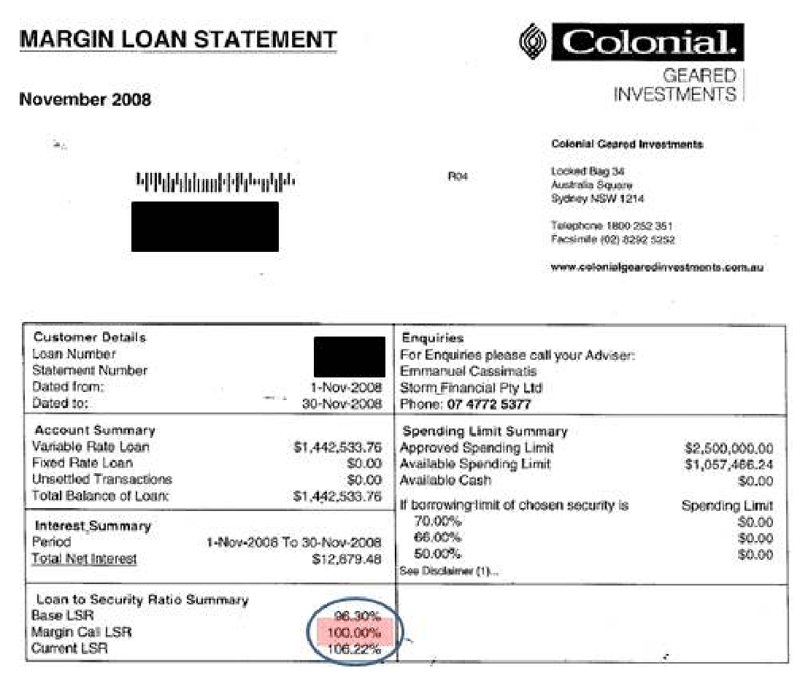Report : Ted Baxter
Content : Carey Ramm AEC Group, Double Gearing explained, Storm Financial advice
Friday 18th February 2012
The good thing about a myth is that it is just that, a myth. Myths can be easily ‘confirmed’ or ‘busted’ simply by looking at the truth. The Plain Truth has conducted an extensive analysis of the concept of ‘Double Gearing’ and illustrated a (hopefully) simple explanation for our readers.
There are more myths circulating about Storm than there are truths. Most such myths The Plain Truth has been able to source back to the CBA and Carey Ramm’s AEC Group. This myth in particular about double gearing emanated mainly from AEC Group of which Carey Ramm is a principal. The misinformed use of the term Double Gearing had been bandied around for many years by novices and has only recently risen to prominence as a convenient tool by the likes of ASIC, the liquidator, the Parliamentary Joint Committee, and CBA for the purpose of demonising Storm. The CBA in particular, as usual, will promote anything to make Storm look bad and at the same time cover its own position, even something that by their own definition the CBA themselves practice.
The incorrect interpretation of ‘Double Gearing’ being put forward is popularly defined as ‘borrowing funds from a loan such as a home equity loan or line of credit, and using those funds to purchase investments. The investments are then used as security for further borrowing via a margin loan.’ Without any further explanation by those who claim that Double Gearing is of itself intrinsically high risk, a huge leap is then made to a conclusion that because this ‘self defined’ double gearing exists, it must automatically be a bad thing. Hence the perception that Storm Financial had some sort of model that promoted highly risky leveraging through so-called double gearing.
The popular double gearing myth assumes that ‘risk of leveraging’ comes from the number of loans a person has. That is a person who has 2 loans is at higher risk than a person who has 1 loan. Similarly a person who has 4 loans is at higher risk than a person who has 2 loans. This is an absolutely absurd and embarrassing proposition. A person who owns $1million in assets and has 5 loans each of $100,000 is no more highly geared or at any more risk than a person who owns $1milllion in assets and has only 1 loan for $500,000.
The real measure of leverage can not even be derived from the total amount of debt a person has. For example, if Mr Norris has a debt of $1,000,000, this would not be considered as leveraged as an average householder with the same amount of debt of $1,000,000.
The true measure of leverage and hence one of the measures of the risk of that leverage is derived by measuring how much debt a person has compared to how many assets that same person has. This measure is expressed as a ratio called a LVR (loan to valuation ratio). For example if Mr Norris has assets worth $50,000,000 and a debt of $1,000,000 then his LVR is 2% which is very low. On the other hand if a young married couple purchased a home worth $1,250,000 with a deposit of $250,000 and a loan of $1,000,000 and the home is their only asset, then they have a LVR of 80%, which is considered high but as we know happens every day.
Accordingly a measure of risk as a consequence of leveraging is not how many loans exist, i.e. whether there is double, triple or quadruple loans etc but what is the relative proportion of liabilities to assets.
When analysing the Storm strategy there was often (but not always) more than one loan, however The Plain Truths understanding from viewing a number of statements of advice provided to us by various clients of Storm indicates that the correct emphasis by Storm was placed on measuring someone’s overall LVR. The usual operating overall LVR range recommended by Storm was from a lower end of 40% to an upper end of 60%. The usual starting margin loan LVR range for retirees was 40% to 50% whilst the range for non-retirees was 50% to 60%. Combine these moderate LVRs with the fact that the investments were made into a highly conservative index fund strategy then the risks seem to be quite sober.
According to a report published on 1 May 2009 in Money Management “Many financial planning dealer groups place a cap on the LVRs clients can employ in margin lending strategies”. The report also stated, “Commonwealth Financial Planning and Financial Wisdom, both Commonwealth Bank of Australia (CBA) owned entities, have maximum LVRs in place of 70 per cent (including credit card and personal debt).” Whilst this Money Management report was clearly written with the intention of vilifying Storm, the facts, even those quoted by Money Management, show the opposite.
Storm Financials Statement of Advice (SoA), an extract of which is shown below, clearly shows a more conservative LVR cap of 60% than what most other dealers who use margin lending recommend. This cap includes the effect that any so-called double gearing would have.

As further proof that Storm was more conservative than most other groups, a margin loan cap of 65% was imposed by Storm on CBA as Storm felt that CBA’s and the industry standard of 70% was overly aggressive.

The extract above is from the CBA agreement with Storm dated 18th May 2007 and clearly indicates that a 65% margin loan LVR starting cap existed for Storm clients. Interestingly this clause also contemplates that markets might fall by reference to the words, “Should a client find themselves at LVR of 65% or above…”
The good thing about a myth is that it is just that, a myth. Myths can be easily ‘confirmed’ or ‘busted’ simply by looking at the truth. As you can see from the above explanation and comparisons, Storms approach to gearing was relatively conservative, the double gearing concept portrayed is a figment of the imagination and the number of loans can not be a measure of leverage risk.
Myth 1: Storm geared clients to 80%

Myth 2: Storm Double Geared is clients

P.S. Actual definition of double gearing according to…

Double Gearing is Used to describe situations where multiple companies are using shared capital to buffer against risk occurring in separate entities without the proper documentation of exposure.

Double Gearing : The act or practice of two or more companies pooling their risk in which each places capital in the other company. In one of the most common examples of double gearing, an insurance company buys shares in a bank, and, in exchange, the bank extends credit to the insurance company.

Double Gearing : A situation in which a number of companies will pool their overall risk by placing capital with each other.
The Plain Truth has been inundated from Storm clients with the question: What can we do to help? The following 2 actions each and every one of you should do.
1) Pass on the information on this website to as many people as possible.
– Family
– Friends
– Neighbours
– Your Professionals (e.g. dentist, doctor, accountant, financial planner, bank manager and bank staff)
– Politicians (local, state and federal)
– Anybody you can…
2) Contact Senator John Williams who is one of the good guys and direct him to the truth with the aim of reopening the Parliamentary Inquiry. John can be contacted via email at [email protected] or 02 6721 4500 or 0427 029 918
The Editor
The Plain Truth,
PO Box 2783
New Farm QLD 4005
Content : Carey Ramm AEC Group, Double Gearing explained, Storm financial advice








